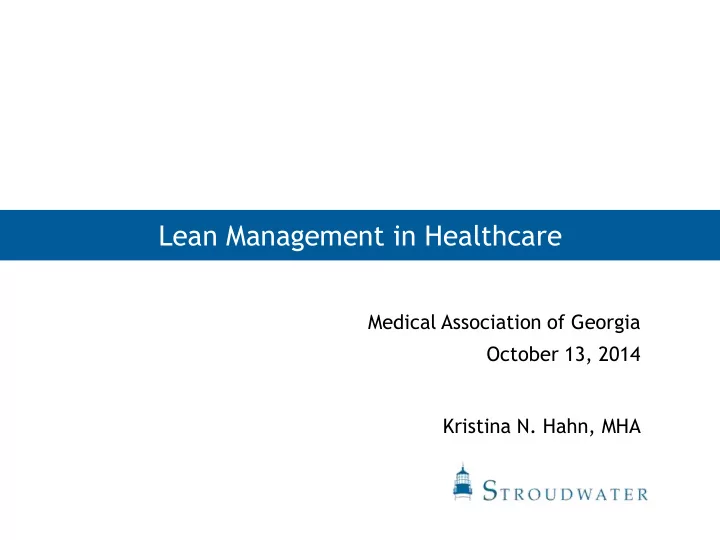

Lean Management in Healthcare Medical Association of Georgia October 13, 2014 Kristina N. Hahn, MHA
What is Lean? • Philosophy derived from the Toyota Production System in the 1990s – the goal was to build ever-better automobiles at ever- lower costs. • Lean simplifies processes by focusing on what adds value and eliminating waste. • Lean is much more than a set of tools – it is also a mindset and a way of life. 2
Lean can help you to… • Improve safety • Reduce errors • Reduce cost • Increase satisfaction • Reduce wait times • Grow volume • Increase staff efficiency • Increase revenue 3
The 5 Principles of Lean 1. Value 2. Value Stream 3. Establish Flow by Eliminating Waste 4. Pull 5. Strive for Perfection 4
1. Value • Value is always defined by the customer . • So many of the activities that consume our time and resources are defined by what is valuable to the physician practice as a business – we fail to focus on what the patients value. • A Lean practice identifies the activities the patient sees as valuable and seeks to eliminate all other activities. • Find out what your patient values: surveys, focus groups, observations, etc. 5
2. Value Stream • Create visual representation of the value stream by mapping the current process. This helps identify waste, issues with flow, or steps that do not add value. • Example - ED Throughput: Patient sent Reg asks patient Patient Presents at Triage nurse to waiting presenting arrives Reg Desk notified room symptoms Bed not clean – Patient sent Patient brought Nurse completes Patient to waiting to triage room registered triage room Patient brought Nurse completes Provider to ED room ED assessment sees Patient 6
3. Establish Flow by Eliminating Waste • Identifying and eliminating waste is key to process improvement • 7 Types of Waste (WORMPIT): • Waiting: delays or idle time involving the patient, physician or staff • Overproduction: producing too much or too soon • Rework: any unnecessary work required due to an error • Motion: any unnecessary movement of patients, staff or physicians • Processing: handling work in a way that is excessive • Inventory: any information or materials waiting to be used • Transportation: unnecessary transfers of materials, information or people 7
ED Throughput Example Patient sent Reg asks patient Patient Presents at Triage nurse to waiting presenting arrives Reg Desk notified room symptoms Bed not clean – Patient sent Patient brought Nurse does Patient to waiting to triage room triage registered room Patient brought Nurse completes Provider to ED room ED assessment sees Patient 8
Making Changes to Eliminate Waste • Some design features to consider in rebuilding the process include: • Don’t move the patient. Instead, where it makes sense, make the work come to the patient. • Eliminate needless work. Perhaps your process includes too many handoffs or outdated steps being completed out of routine. • Because face-to-face time with the provider is often the most valuable part of the visit, do everything you can to make the provider more efficient and effective. • Make sure your process involves direct communication between parties. 9 Source: Endsley S, Magill MK, Godfrey MM. Creating a Lean Practice. Family Practice Management. April 2006:34-38.
4. Pull • Taiichi Ohno (founder of Toyota Production System) learned this principle from visiting American supermarkets • Vendors do not replace fresh fruit until consumers “pull” it from the shelves • If we replenish only what the customer requires or demands, we are not left with any waste 10
4. Pull • In healthcare, pull is used primarily to regulate the reordering of supplies and their delivery to their point of use. • It can also be used for scheduling and moving patients through a process. • The goal is to eliminate having more items or people in the system than what the system can handle. 11
Map the Redesigned Process • Re-map your process, accounting for changes you believe will eliminate waste, improve flow and maximize value. Reg asks patient Triage nurse Patient Presents at presenting notified arrives Reg Desk symptoms Patient brought to Nurse Triage/Exam Provider sees Full bed (immediate notifies Bedside Patient Registration bedding) provider 12
5. Strive for Perfection • This final principle allows your practice to continuously strive for excellence and not rest when progress is made • Test your changes and make continuous improvements until the process is close to perfection • Never stop pursuing: • Excellence • Commitment to quality • Total employee involvement 13
Where do you go from here? • It starts at the top • Engage employees • Designate a process i mprovement “expert” • Begin identifying opportunities for improvement • Work through each initiative, one at a time • Celebrate wins, big and small • Encourage continuous improvement 14
Questions? Contact Information: Kristina N. Hahn Consultant Stroudwater Associates khahn@stroudwater.com (404) 890-7255 www.stroudwater.com 15
Recommend
More recommend